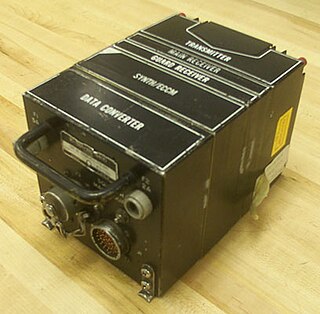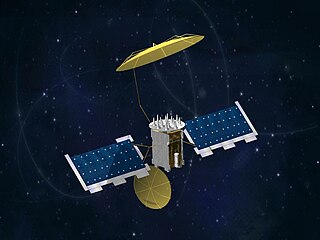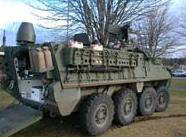Related Research Articles

MIL-STD-188 is a series of U.S. military standards relating to telecommunications.

Very high frequency (VHF) is the ITU designation for the range of radio frequency electromagnetic waves from 30 to 300 megahertz (MHz), with corresponding wavelengths of ten meters to one meter. Frequencies immediately below VHF are denoted high frequency (HF), and the next higher frequencies are known as ultra high frequency (UHF).

Software-defined radio (SDR) is a radio communication system where components that have been traditionally implemented in hardware are instead implemented by means of software on a personal computer or embedded system. While the concept of SDR is not new, the rapidly evolving capabilities of digital electronics render practical many processes which were once only theoretically possible.

Ultra high frequency (UHF) is the ITU designation for radio frequencies in the range between 300 megahertz (MHz) and 3 gigahertz (GHz), also known as the decimetre band as the wavelengths range from one meter to one tenth of a meter. Radio waves with frequencies above the UHF band fall into the super-high frequency (SHF) or microwave frequency range. Lower frequency signals fall into the VHF or lower bands. UHF radio waves propagate mainly by line of sight; they are blocked by hills and large buildings although the transmission through building walls is strong enough for indoor reception. They are used for television broadcasting, cell phones, satellite communication including GPS, personal radio services including Wi-Fi and Bluetooth, walkie-talkies, cordless phones, satellite phones, and numerous other applications.

Single Channel Ground and Airborne Radio System (SINCGARS) is a Combat-net radio (CNR) used by U.S. and allied military forces. The CNR network is designed around three systems: SINCGARS, the high frequency (HF) radio, and the SC tactical satellite (TACSAT). Each system has different capabilities and transmission characteristics. SINCGARS is a family of user-owned and operated, very high frequency-frequency modulation (VHF-FM) CNRs. In the CNR network, the SINCGARS’ primary role is voice transmission for command and control (C2) between surface and airborne C2 assets. SINCGARS can transmit and receive secure data and facsimile transmissions through simple connections with various data terminal equipment.
Radio propagation is the behavior of radio waves as they travel, or are propagated, from one point to another in vacuum, or into various parts of the atmosphere. As a form of electromagnetic radiation, like light waves, radio waves are affected by the phenomena of reflection, refraction, diffraction, absorption, polarization, and scattering. Understanding the effects of varying conditions on radio propagation has many practical applications, from choosing frequencies for amateur radio communications, international shortwave broadcasters, to designing reliable mobile telephone systems, to radio navigation, to operation of radar systems.

A walkie-talkie, more formally known as a handheld transceiver (HT), is a hand-held, portable, two-way radio transceiver. Its development during the Second World War has been variously credited to Donald Hings, radio engineer Alfred J. Gross, Henryk Magnuski and engineering teams at Motorola. First used for infantry, similar designs were created for field artillery and tank units, and after the war, walkie-talkies spread to public safety and eventually commercial and jobsite work.

A two-way radio is a radio that can both transmit and receive radio waves, unlike a broadcast receiver which only receives content. It is an audio (sound) transceiver, a transmitter and receiver in one unit, used for bidirectional person-to-person voice communication with other users with similar radios. Two-way radios are available in stationary, mobile, and hand-held portable models. Hand-held two-way radios are often called walkie-talkies, handie-talkies or hand-helds. Two-way radios are used by groups of geographically separated people who need to keep in continuous voice communication, such as aircraft pilots and air traffic controllers, ship captains and harbormasters, emergency services personnel like firefighters, police officers, and ambulance paramedics, taxi and delivery services, soldiers and military units, fast food and warehouse employees, and radio amateurs.

The Joint Tactical Radio System (JTRS) aimed to replace existing radios in the American military with a single set of software-defined radios that could have new frequencies and modes (“waveforms”) added via upload, instead of requiring multiple radio types in ground vehicles, and using circuit board swaps in order to upgrade. JTRS has seen cost overruns and full program restructurings, along with cancellation of some parts of the program. JTRS is widely seen as one of the DoD's greatest acquisition failures, having spent $6B over 15 years without delivering a radio.

HAVE QUICK is an ECM resistant / frequency-hopping system used to protect military aeronautical mobile (OR) radio traffic.

The Mobile User Objective System (MUOS) is an United States narrowband military communications satellite system that supports a worldwide, multi-service population of users in the ultra high frequency (UHF) band. The system provides increased communications capabilities to newer, smaller terminals while still supporting interoperability with legacy terminals. MUOS is designed to support users who require greater mobility, higher bit rates and improved operational availability. The MUOS was declared fully operational for use in 2019.
Bowman is the name of the tactical communications system used by the British Armed Forces.

In air traffic control, an area control center (ACC), also known as a center or en-route center, is a facility responsible for controlling aircraft flying in the airspace of a given flight information region (FIR) at high altitudes between airport approaches and departures. In the US, such a center is referred to as an air route traffic control center (ARTCC).

Satcom on the Move (SOTM), or satellite communications on the move, is a phrase used in the context of mobile satellite technology, specifically relating to military ground vehicles, Maritime and Airborne platforms. The basic principle behind Satcom On The Move is that a vehicle equipped with a satellite antenna is able to establish communication with a satellite and maintain that communication while the vehicle is moving.

The AN/ARC-164 is an aircraft station that operates in the aeronautical mobile (OR) service / B band (NATO). It was first introduced in 1981 and might be found on B-52G/H, B-1B, C/EC/RC-26D, C-5, KC-135, C-23, C-130, C-141, F-15, A-10, F-16, UH-1D, CH-47, H-53, H-60 and S-3B aircraft.

The AN/PRC-152 Multiband Handheld Radio is a portable, compact, tactical software-defined combat-net radio manufactured by Harris Corporation. It is compliant without waivers to the Joint Tactical Radio System (JTRS) Software Communications Architecture (SCA). It has received NSA certification for the transmission of Top Secret data.

The AN/PRC-117 Multiband Manpack Radio, or Multiband Multi Mission Radio (MBMMR), is a man-portable, tactical software-defined combat-net radio, manufactured by Harris Corporation, in two different version:

The ARC-210 is a family of radios for military aircraft that provides two-way, multi-mode voice and data communications over a 30 to 512+ MHz frequency range. It covers both Ultra High Frequency (UHF) and Very High Frequency (VHF) bands with AM, FM and SATCOM capabilities. The ARC-210 radio also includes embedded anti-jam waveforms, including Havequick and SINCGARS, and other data link and secure communications features, providing total battlefield interoperability and high-performance capabilities in the transfer of data, voice and imagery. It features a separate guard receiver for monitoring 121.5 and 243 MHz while simultaneously monitoring the active channel selected. Transmitter power ranges from 5 to 23 watts, depending on frequency and mode. The radios communicates with other avionics over a MIL-STD-1553 data bus.
The AN/ARC-182 is a family of military aircraft radio transceivers designed for two-way, multi-mode voice communications over a 30 to 400 MHz frequency range. It covers both Ultra High Frequency (UHF) and Very High Frequency (VHF) bands with AM, FM, as appropriate. The ARC-182 radio supports the HAVE QUICK II anti-jam waveforms, with an optional control unit. It features a guard channel capability for monitoring 40.5, 121.5, 156.8 and 243 MHz. Transmitter minimum power is 10 watts, AM, and 15 watts, FM. The RT-1250A model radio can communicate with other avionics over a MIL-STD-1553 data bus.